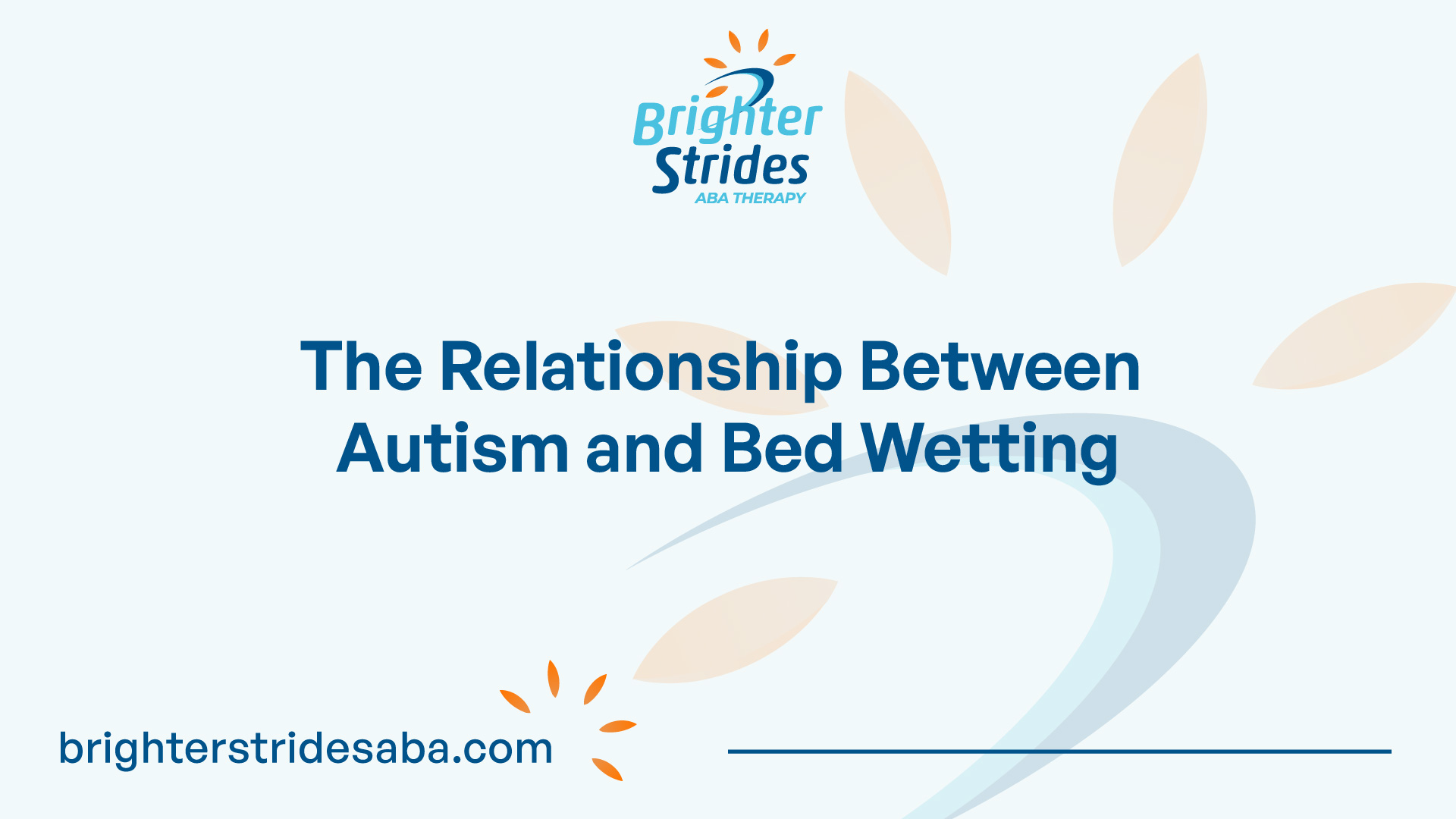Understanding Bed Wetting in Autism
Bed wetting, also known as nocturnal enuresis, is a common issue among individuals with autism. Understanding the prevalence and impact, as well as the causes and contributing factors, is essential in addressing this challenge.

Prevalence and Impact
Studies have shown that the prevalence of bed wetting in children with autism can range from 10% to 40%, which is significantly higher than the general population. Approximately 20% of children on the autism spectrum experience bed wetting, compared to 7% in the general population. Children with autism spectrum disorders had a bed wetting prevalence of 27%, while typically developing children had a prevalence of 16%, and children with ADHD had a prevalence of 9% [2].
Bed wetting can have a significant emotional and social impact on individuals with autism. It can lead to feelings of embarrassment, shame, and frustration. Additionally, it can pose practical challenges for individuals and their caregivers, such as concerns about sleepovers and managing laundry.
Causes and Contributing Factors
Various factors contribute to bed wetting in individuals with autism. Late toilet training and difficulties with toilet training are common in autistic children, which can contribute to bed wetting issues. Autistic children might wake because they’re wetting the bed or struggle to get back to sleep after waking up to go to the toilet.
Physical factors, such as delayed development in bladder control, can also play a role in bed wetting among individuals with autism. Sensory issues related to bladder control and sensory processing challenges can contribute to bed wetting incidents as well.
Furthermore, behavioral and emotional factors can influence bed wetting in individuals with autism. Anxiety and stress can disrupt sleep patterns and contribute to bed wetting incidents. Communication difficulties and social challenges may also impact an individual’s ability to express their need to use the bathroom or seek assistance.
Understanding the prevalence, impact, and underlying causes of bed wetting in autism is crucial in developing effective strategies for management and support. By addressing these factors, caregivers and individuals with autism can work towards minimizing the challenges associated with bed wetting and improving overall well-being.
Physical Factors of Bed Wetting in Autism
Understanding the physical factors that contribute to bed wetting in individuals with autism is essential in addressing this issue. Two important factors to consider are bladder control development and sensory processing challenges.
Bladder Control Development
Delayed development of bladder control is a physical cause of bed wetting in individuals with autism. Children with autism may experience delays in the maturation of their bladder muscles and nerves, which can impact their ability to control urination. This delay can make it difficult for them to recognize the need to urinate or to respond appropriately when their bladder is full.
Late toilet training and toilet training difficulties are common in autistic children, which can contribute to bed wetting issues. Autistic children might wake up because they’re wetting the bed or struggle to get back to sleep after waking up to go to the toilet.
Sensory Processing Challenges
For individuals on the autism spectrum, sensory processing challenges are often present. These challenges can contribute to bed wetting by disrupting the recognition of body signals and interfering with appropriate responses. Some individuals with autism may have difficulties recognizing the need to urinate or responding appropriately when their bladder is full due to sensory processing issues [1]. Sensory sensitivities can also disrupt sleep patterns, making it more difficult to wake up when they need to use the bathroom during the night.
Additionally, overproduction of urine by the kidneys during the night, delayed maturation of the bladder, and constipation are factors that can contribute to bed wetting in children with autism. These physical factors, combined with sensory processing challenges, can make it more difficult for individuals with autism to achieve consistent nighttime bladder control.
Understanding the physical factors involved in bed wetting in individuals with autism is crucial for developing effective strategies and interventions to address this issue. By considering these factors, caregivers and professionals can provide appropriate support and guidance to help manage bed wetting and improve the quality of life for individuals with autism.
Behavioral and Emotional Factors
When exploring the relationship between autism and bed wetting, it’s important to consider the behavioral and emotional factors that can contribute to this issue. Two significant factors in this regard are anxiety and stress, as well as communication and social challenges.
Anxiety and Stress
Anxiety and stress can have a significant impact on sleep patterns and contribute to bed wetting in individuals with autism. The challenges faced by individuals with autism, such as difficulties in social interactions, sensory sensitivities, and communication, can lead to heightened levels of anxiety and stress. These factors can disrupt sleep and make it more difficult for individuals to maintain bladder control during the night.
Social anxiety, which is common among individuals with autism, can also contribute to bed wetting. Many individuals with autism experience challenges in social situations and may feel anxious or overwhelmed, particularly when it comes to issues related to bed wetting. Fear of judgment or embarrassment can trigger anxiety, further exacerbating the problem.
Communication and Social Challenges
Communication difficulties and social challenges are additional factors that can play a role in bed wetting among individuals with autism. Some individuals with autism may struggle to effectively communicate their need to use the bathroom or have difficulty understanding social cues related to toileting. These challenges can make it harder for individuals to recognize and respond to the body’s signals, leading to bed wetting incidents.
The difficulties in social interactions faced by individuals with autism can also contribute to feelings of anxiety and stress, as well as a sense of isolation. These emotional factors can further impact sleep patterns and contribute to bed wetting incidents.
Understanding the behavioral and emotional factors that contribute to bed wetting in individuals with autism is crucial in developing effective strategies for managing this issue. By addressing anxiety, stress, and communication challenges, caregivers and professionals can provide the necessary support and interventions to help individuals with autism achieve better sleep hygiene and manage bed wetting more effectively.
Managing Bed Wetting in Autism
Bed wetting can be a challenging issue for individuals with autism, but there are strategies and support available to help manage this condition effectively.
Strategies and Support
Creating a supportive environment is essential when managing bed wetting in individuals with autism. Here are some strategies that can be helpful:
- Establish a Consistent Bedtime Routine: A structured bedtime routine can provide predictability, which can be comforting for individuals with autism. This routine should include regular bathroom breaks before sleep to help empty the bladder.
- Address Sensory Needs: Sensory processing challenges can contribute to bed wetting in individuals with autism. Pay attention to sensory triggers and make adjustments to the sleep environment, such as using soft bedding or weighted blankets, to promote better sleep and reduce anxiety.
- Support Communication Development: Encouraging individuals with autism to express their needs and feelings can help in managing bed wetting. Communication tools, such as visual schedules or social stories, can be used to facilitate effective communication and understanding.
- Create a Supportive and Calming Environment: Minimize distractions in the bedroom and create a soothing atmosphere that promotes relaxation. Consider using white noise machines or nightlights to reduce anxiety and promote better sleep.
- Address Sleep Disturbances: Addressing sleep disturbances, such as insomnia or sleep apnea, can help reduce bed wetting incidents. Consult with healthcare providers to identify and address any underlying sleep issues.
Professional Guidance and Interventions
Seeking professional help is crucial when managing bed wetting in individuals with autism. Healthcare providers and therapists can provide valuable guidance and support. Here are some interventions that may be recommended:
- Consult with Healthcare Providers: It’s important to consult with healthcare providers, such as pediatricians or urologists, to rule out any underlying medical conditions that may contribute to bed wetting. They can provide guidance on potential treatment options or medications if necessary.
- Explore Therapy Options: Therapy options, such as Applied Behavior Analysis (ABA) therapy, can be beneficial for managing bed wetting in individuals with autism. ABA therapy focuses on behavior modification techniques that can help address toileting skills and promote bladder control.
- Behavioral Interventions: Behavior modification techniques, such as positive reinforcement or reward systems, can be effective in encouraging dry nights and promoting successful toileting habits. Working with a behavior specialist or therapist experienced in autism can provide valuable guidance in implementing these interventions.
Remember that managing bed wetting in individuals with autism requires patience, understanding, and a multidisciplinary approach. By implementing effective strategies, creating a supportive environment, and seeking professional guidance, it’s possible to manage and reduce bed wetting incidents, leading to improved quality of life for individuals with autism.
References
- https://www.apexaba.com/blog/autism-and-bed-wetting
- https://www.yellowbusaba.com/post/autism-and-bed-wetting
- https://www.supportivecareaba.com/aba-therapy/autism-and-bed-wetting
- https://raisingchildren.net.au/autism/health-wellbeing/sleep/sleep-problems-children-with-asd
- https://www.myteamaba.com/resources/autism-and-bed-wetting/
- https://www.adinaaba.com/post/bed-wetting-in-autism
- https://www.ambitionsaba.com/resources/autism-and-bed-wetting

 We've just released an article! Check out our blog!
We've just released an article! Check out our blog! 


